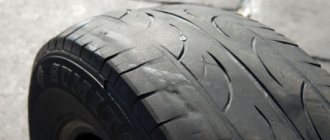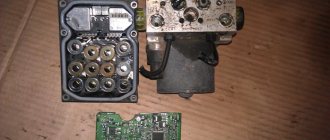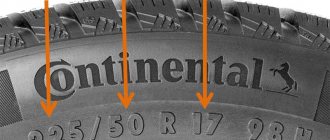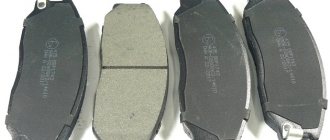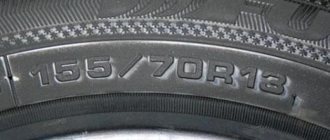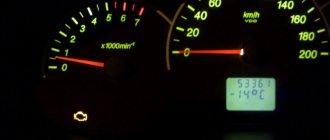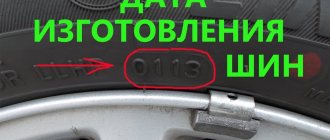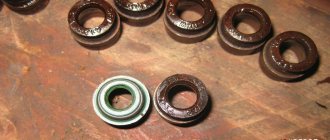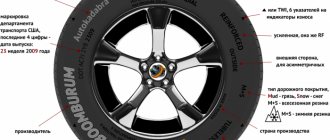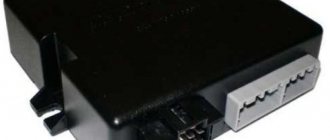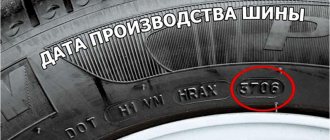A car tire must always be in good condition. Before the trip, the condition of the tires is checked. It is worth looking at the tread pattern. During regular examination, his condition is assessed. A tire tread wear indicator will help you check the depth of the grooves. They are different, it is worth considering this element of the tire in more detail.
What are the dangers of tire wear?
Many drivers pay attention to the condition of their tires only in winter. Slippery roads cause frequent accidents, so motorists change their car in time. In the summer, when the road is dry, many people believe that using worn tires will not bring any danger. They are very wrong. Using old tires is dangerous at any time of the year and in any weather. Let's look at some of the implications of this:
- The car becomes uncontrollable.
- The braking distance of the car increases, and this can lead to a traffic accident.
- Hydroplaning occurs - as a result of the appearance of a water layer between the road surface and the car, traction with the road is completely or partially lost.
- The car may turn around unexpectedly, then an accident cannot be avoided.
- If tires wear unevenly and pressure increases, a rubber explosion may occur.
Driving on bald tires is prohibited at any time of the year. In case of violation, drivers face a fine of 500 rubles or a warning.
Checking a used car using Autocode
Buyer vigilance will guarantee a good deal. Bad tires despite the overall good condition of the car are not always a reason to refuse to buy. If wear is natural and uniform, and also corresponds to the average service life of tires, the option of purchasing a car is worth considering. Over time, you can always replace the tires with ones that will inspire confidence.
To ensure that during inspection there are no doubts about the history of the car you are purchasing, check the history of the car using the Autocode online service. To obtain a complete report, only the VIN, chassis number or license plate number of the vehicle in question is required.
By entering unique vehicle numbers, you will receive the following data:
- Year of issue;
- Number of owners;
- True mileage of the car;
- Participation of the car in an accident and indication of the most damaged parts;
- The car is secured by the bank;
- Using a car in a taxi;
- Carrying out repair work.
Tire wear or other negative factors may be hidden by the seller. To prevent them from subsequently leading to problems in other parts of the machine, order an Autocode on-site inspection. A specialist will arrive on site at any time and conduct a professional inspection of the vehicle. Checking the car through Autocode will help you verify the correctness of your assumptions or refute them.
How to tell if a tire is worn out or not
Most evaluation methods are available to the average user, although not all of them.
Tire appearance
A lot can be appreciated visually. For example, the color of rubber loses its saturation over time, and tires become characteristically whitish. This is a good sign that aging has occurred due to oxidation of the tire material.
Mechanical damage is also visible, both natural in the form of age-related cracks and delamination, and artificial, traces of numerous repairs, exposure of the cord due to cuts, convexity of the profile under pressure (bumps).
Uneven tread wear in the form of saw-tooth or bald spots is clearly visible. Such a wheel is dangerous when braking.
Profile depth measurement
To estimate the actual residual value, it is necessary to know the original tread size, as well as the minimum allowable for a particular tire model. A big mistake that sellers most often intentionally make is to calculate percentages based on absolute depth.
The tire cannot be used until it is completely worn out. Moreover, based on its intended purpose, rubber can completely lose its properties even with a sufficiently deep pattern.
This applies to winter, mud and all-season tires. They must effectively remove the soft component of the road surface from the contact zone, which is only possible with a sufficiently deep tread.
Digital indexes on the protectors
This is the most convenient way to determine wear, built into the tire design by the manufacturer. The tread rubber has indentations in the form of numbers, which disappear as the rubber wears off. The largest of the remaining ones determines the resource height of the relief.
Other indications are also possible; all types are simple and as intuitive as possible.
This is interesting: How and how to glue molding on a car door
To the extent that some manufacturers use color indication, when rubber of a different shade is embedded in the depth of the tread. A worn treadmill will then change its color to one that contrasts with the other surface.
Handy methods
Although it is almost impossible to find modern tires without wear indicators at all, the old methods continue to work. Between the blocks or tread tracks you can place a caliper depth gauge, which will show the remaining depth in millimeters.
All that remains is to subtract the minimum acceptable value from the resulting number. If you don't have a caliper, you can use a ruler, or even just a coin.
Wear assessment criteria
As a rule, sellers at the market or in a tire shop offer used wheels (usually sold in pairs) and state the degree of wear as a percentage - from 10 to 30%. The idea is simple - to lure an ignorant buyer with the appearance of the product, diverting attention from other, no less important nuances. Often, sellers themselves do not understand the depth of the issue and incorrectly determine the suitability of the rubber for further use.
You can check the wear of car tires using three main criteria:
- Minimum permissible tread height in the most worn area.
- Uniform abrasion across the entire working surface of the slope.
- Tire age.
Advice. Knowing how to correctly assess the further performance of wheels, do not enter into discussions with dealers and do not try to convince them that you are right - you will waste your time and nerves in vain. Just choose the best set of tires and install it on your car.
To assess the condition of the tires used on the car, also use a combination of the listed criteria. It is impossible to be guided by the minimum tread height - there are other critical defects that lead to the replacement of slopes that look quite functional.
Why is it important to know your tire wear?
The main characteristics of car tires are provided by a convex pattern applied to their surface - the tread. Thanks to the tread, a contact patch between the tire and the road tread is formed, the wheel’s engagement with the road is ensured, and most importantly, the tread removes water, dirt and slush from under the wheel, ensuring better contact with the road surface.
However, rubber is constantly subject to wear, so over time the tread wears out and its height decreases. This entails a number of negative consequences, including a decrease in the speed at which “aquaplaning” begins, deterioration in controllability, an increase in the likelihood of skidding, etc., and wear on the tread of trucks and tractors also reduces the cross-country ability of these vehicles. Ultimately, excessive tire wear reduces vehicle safety and can cause an accident.
Therefore, tread height is strictly regulated by law, and every driver must comply with the established tire wear requirements. The remaining tread height, upon reaching which the tires can no longer be used, is established by paragraph 5 of the “List of faults and conditions under which the operation of vehicles is prohibited,” which is an appendix to the traffic regulations.
- Tire CORDIANT Business CA
4 250 ₽
- Tire Forward Professional 156 AShK tubeless
2 990 ₽
- Tire VIATTI Brina Nordico V-522 stud.
2 650 ₽
- Tire LTA-401 Rosava
6 890 ₽
- NOKIAN Nordman 5 stud tire.
3 120 ₽
- U-2 Nizhnekamsk 10-ply tire with tube
7 450 ₽
- Tire SATOYA SU-022 with tube and ob. tape
8 790 ₽
How wear occurs on the inside of a wheel when rolling with slippage
Uneven tread wear is caused by rubber slipping at the point of contact with the road surface, which is caused by improper wheel toe adjustment. Violation of the settings leads to the fact that the plane of rotation of the wheel rim does not coincide with the direction in which the wheel is rolling.
A hard wheel without a soft rubber tire (for example, a wooden cart wheel) slips along the road surface if there is a minimal deviation of the plane of its rotation from the trajectory of movement. Since car rims are equipped with elastic tires, if the wheel toe-in indicator slightly deviates from the norm, the tires will not wear out quickly.
With correctly adjusted toe-in, when the wheel rolls, all the tread pattern blocks experience elastic deformation by lateral force until each individual element leaves contact with the road surface. As long as the force of elastic deformation of an individual tread block does not exceed the force of adhesion to the road, the elements of the tire pattern do not slip, and, therefore, accelerated wear of the rubber does not occur.
Different tires have different elasticity characteristics. This indicator is determined by the softness of the tread, the elasticity of the tire frame and the geometry of the rubber profile (narrower tires with a high profile have better elasticity indicators). Thus, we found out that different types of tires can “forgive” different wheel toe deviations. Many tires that are equipped with passenger cars can normally tolerate up to twenty arc minutes of cumulative toe deviation from the norm.
How can the above information be useful for car enthusiasts? Understanding the rubber wear process will help identify uneven tire wear at an early stage. This will make it possible to detect tire wear in time and understand what caused it. It is necessary to carefully study the shape of the contact surface of the tread pattern elements. In addition, you need to run your palm along the tread surface in the direction of rotation of the wheels and against it. Then you should run your palm across the tread - from one side of the tire to the other and in the opposite direction.
Accelerated wear of rubber on the inside of the wheel, which occurs as a result of slippage due to improper wheel toe adjustment, forms a special tire abrasion pattern. This pattern is called a “saw” (each individual element of the tread pattern wears away so that it takes on a shape similar to a saw tooth).
When the wheels wear unevenly, one of the edges of the tread “checkered” becomes sharper and rises above its other edge, which rounds and becomes less high. The forming teeth of the “saw” can have a transverse or longitudinal orientation (the direction of their bevel goes across or along the direction of rotation of the wheel).
Internal wear of a wheel in the form of saw teeth is due to the fact that when the toe-in index diverges from the norm, when the car moves, the front edge of the tread block contacts the road surface without slipping and, therefore, it does not wear out and begins to rise above the other (erasable) edges . With further movement of the pattern element in the contact patch with the road, shear stress accumulates in the body of the tire material. As a result, the “checker” begins to slip and other edges, as they wear out, become smoother and lowered.
If the tire tread slips in the contact patch, then, in most cases, a longitudinal “saw” is formed on it. This type of internal wear indicates a violation of the toe adjustment along the wheel axis. If such a defect is detected, you should contact a car service for diagnostics. At the same time, it should be taken into account that there are a number of other conditions under which a longitudinally directed “saw” in the tread pattern can be felt, despite normal toe-in indicators (and it is impossible to get rid of such a “saw”). The likelihood of wear of this form depends on the type of tire, suspension characteristics, seasonal characteristics of the road surface, etc.
Transversely directed “saw” teeth, as a rule, can be felt on the tread surface when the tires are slipping particularly strongly (the toe settings are severely disturbed and, therefore, the wheel “is actually eating rubber”).
The direction of the “teeth” of the transverse “saw” indicates in which direction the wheel is turned in toe (the toe indicator is positive or negative).
This is what a rip saw looks like when worn:
Traffic regulations
One of the key characteristics that is responsible for vehicle controllability and stability on the road is the tire tread height. Sometimes it is not possible to objectively assess this indicator by eye. In this case, a special indicator that is integrated into the rubber by the manufacturer will not help. It is the tread that provides high-quality traction between the wheel and the road surface, and it is especially important to monitor its degree of wear in bad weather. During and after rain, snow, and ice, the vehicle's contact with the road deteriorates significantly.
The traffic rules, for their part, regulate what the degree of wear should be, and clear quantitative indicators are provided for this:
- passenger cars - 1.6 mm;
- motorcycles - 0.8 mm;
- buses - 2 mm;
- trucks – 1 mm.
And in order to assess the tread height, we just need an indicator indicating tire wear. It is a part of the tread that differs in position, shape and size from the rest of the tire pattern. Most often, such an indicator is volumetric and placed in a groove. Another option is a digital beacon in the form of digital markings at different depths.
Triangle designation
Tread height is an important aspect that needs to be monitored during vehicle operation. It is high-quality tires that ensure the proper size of the contact patch between the tire and the road surface and strong grip on the surface. This allows you to neutralize the effect of aquaplaning and creates traffic safety.
Triangle tire wear indicator
It is very important to monitor tire wear indicators. Modern technologies make it possible to do this thanks to special indicators applied to the tire.
When choosing tires for a car, the driver must be able to read the markings. The basic designations that many car enthusiasts know about are:
- d – bore diameter;
- s – profile width;
- D – outer diameter;
- h – series;
- H – profile height.
Decoding tire markings
There are also additional types of markings that not every driver may know about. It is these symbols that are of great importance when choosing tires, especially if you are buying used products rather than new ones.
This is an indicator of uniform tread wear. Manufacturers depict it in the form of a small triangle with an upward angle. This is one of the most popular designations.
Pirelli, Goodyear, Toyo, Hankook, Yokohama - all these brands put a triangle on their tires.
As a rule, manufacturers place the so-called Treadwear Indicator (TWI) on the side of the tire at the same distance along the entire diameter of the tire.
Manufacturers place the Tread Wear indicator on the side of the tire at an equal distance
The level of wear on a car tire may be uneven, so such indicators should be viewed over the entire area of the tire. For example, if the car's wheel alignment is not adjusted, the pattern on the side of the tire will be erased. This type of rubber can no longer be used.
Main types of indicators
The simplest is a volumetric type determinant, which functions simply and clearly. As the tread wears off, it begins to compare with the height at which the beacon is located. This means that the tire must be replaced. Today, manufacturers equip tires with not only the main indicators, but also intermediate ones, so that the driver can monitor the wear of the pattern in advance and prepare for replacement.
We recommend: What you need to know about car alarms
The digital indicator on the tires looks somewhat different. Represents numbers extruded into the tire at a certain depth. The smallest number (usually 2) is at the greatest depth and vice versa. During operation, the tread will wear out, and the numbers themselves, accordingly, will disappear. As soon as the last one disappears, it means that the rubber has reached a critical level of wear. It is digital beacons that have become most widespread for the reason that they do not need to be deciphered, and even a child can understand their meaning.
Where is he located?
It is part of the tread and is located in the recess between the checkers. This applies to all tires, be it products or Bridgestone. The tire tread wear indicator may differ only in its shape. Some manufacturers provide a separate checker for it, which is divided into several parts. Each of them has a different thickness.
For example, the height of the tread wear indicator on L-5s winter tires can be eight, six and four millimeters. On summer ones, a convex stripe is often used as an indicator. Its thickness is usually about two millimeters.
At the moment, there are several types of tire tread wear indicators:
- Volumetric. They are a convex line that is located in the groove of the pattern.
- Digital. These are numbers pressed into the tread with different thicknesses. Often used on winter tire models.
- Strokes. They have different depths. The bars are also located in the tread grooves.
The simplest indicator of tire tread wear is volumetric. How does he work? As the tread wears, this indicator merges with the pattern. This indicates that the tire is critically worn. It needs to be replaced. On some models, in addition to the main ones, there are also intermediate indicators. They warn the driver that the tread height has decreased and the tire will soon require replacement. But usually such a tire can be used for another 20-25 thousand kilometers.
As for digital ones, they have two degrees of depth. The largest number used here is 8. It informs the driver that the tread remaining is at least eight millimeters. This designation can be on both winter and summer tires. But the indicator of critical wear has different values depending on the season. So, the smallest number on summer tires is two millimeters. And in winter - four. But experts say that a winter tire should be changed already with a tread thickness of 5-6 millimeters. Yes, no one will prohibit you from driving on such tires. But the quality of contact with the road (especially if it is loose snow) will be questionable.
Helpful advice: if the wear of winter tires is approaching critical, it is worth taking snow chains with you. This way you can get out of the snow captivity without any problems.
The digital Kumho tire tread wear indicator may have different designations. Instead of single-digit numbers, double-digit numbers are used here. They talk about the percentage of tread remaining, which is also quite convenient.
Types of tire wear indicator
Despite the fact that the wear indicator of different brands of treads looks different, one thing remains the same:
- the indicator is made of the same rubber as the tire;
- The height of the indicator never falls below 1.6 mm.
In principle, for all tire brands, four types of wear indicators are most often found:
- in the form of a cord-shaped straight transverse “influx” relative to the tread grooves;
- in the form of volumetric numbers (usually the numbers are set from 2 to 8), standing out in relief against the background of the surface of the tread blocks;
- in the form of a symbol - for example, a drop of water (this designation is always adjacent to the digital designation of the tread thickness!);
- in the form of a change in the original tread color.
Quantity, shape
Typically there are six wear indicators on one tire. They are located at the same distance from each other, evenly around the entire circumference of the wheel. The location of the indicator can be indicated by special markings. It is applied opposite the mark in the shoulder area of the tire. Also note that the shape of the indicators can be different:
- Snowflake. This is an indicator of tread wear on Nokian tires used in winter. This designation is not used on summer tires.
- Triangle. Found on summer tires of different brands. May come with the abbreviation TWI. This triangle is directed with its upper end towards the tread. May have varying degrees of thickness depending on the brand and model of the tire.
- Corporate logo. A striking example of this is the figure of Bibendum on French Michelin tires.
This number of indicators is made for the convenience of determining tire wear. You can find out how much the tire has gone bald in any position of the wheel.
Where is the indicator located on the tire?
Most often, a tire wear level indicator (it may be absent on winter models!) is installed at the bottom of the tread groove: this is logically justified from the point of view of its gradual wear.
Visually, such a signaling device looks like a kind of “fused-on” column connecting two or three (sometimes four) tread “checkers” of different heights.
If you have difficulty finding the indicator, you can always clarify its location by examining the markings on the side of the tire.
If the tire wear indicator is made in the form of a change in their color, then, of course, there will be no grooves or raised numbers on the tread, since the tread itself consists of two multi-colored layers. During operation, the first layer of optimal driving thickness gradually wears off, and in its place a deeper layer of a different, contrasting color appears.
Tire wear index
Each manufacturer indicates a so-called wear index on the tire profile, which most often looks like the inscription “Treadwear 100” and means a maximum of 48,000 km on a standard road surface (test site). In a real environment and often not the most ideal roads, this number actually needs to be divided by 1.5 - we get 36,000 km.
By analogy, if the wear resistance index is 150, then this means “factory” 72 thousand km, 200 – 96 thousand km, and so on.
Why are worn tires dangerous on the road?
- adhesion to the road surface deteriorates, which leads to an increased likelihood of skidding, accidents, and aquaplaning in the event of rainy weather;
- cross-country ability in off-road conditions decreases;
- the risk of a tire puncture while driving increases.
It is also worth remembering that the issue of tire wear is regulated by traffic rules, and you can get a fine for using “bald” tires. Knowing what maximum tire wear is permissible, this can easily be avoided: 1.5-2 mm for summer ones, and 4-5 mm for winter ones (a more accurate figure is indicated by the manufacturer).
Tire rotation direction. Asymmetrical tires
Not all tires are the same. There are tires for which the direction of rotation of the wheel matters, and which side of the wheel faces outward and which side faces inward. Such tires are called directional , or with an asymmetric tread pattern .
The correct direction of wheel rotation is indicated by an arrow and the word Rotation.
There are also inscriptions like outside . Which means you need to install the tire with this side facing out.
How to determine the side of a tire
Such measures are due to the asymmetrical or directional tread pattern, which is designed for effective adhesion to the surface. If the pattern is directional, it means that it only provides the desired tire performance when rotated in the desired direction.
Symmetrical and asymmetrical tread types
Uneven tire wear: how to determine, reasons, dangers
If measurements show different results in different parts of the tread, it is important to determine exactly how your tires are wearing in order to understand where and what the operating error is.
If the tread is more worn on the sides and less worn in the center, this means that the tire pressure is insufficient and the contact patch with the road is not correct. This leads not only to poor vehicle stability, but also to increased fuel consumption.
If the tread is worn down in the middle but the sides are fine, this means your tires are overinflated. Sometimes this is done deliberately in order to save fuel, but in this case the tires will still have to be changed ahead of schedule.
There is also the possibility of increased wear on the inner or outer side of the tread - this signals improper wheel camber. A visual table with wear options and its causes:
What causes tires to wear out faster?
But the shelf life of tires established by GOSTs and declared by manufacturers can only be relied upon in ideal conditions. Circumstances that bring the tire replacement closer include:
- Improper storage. This can be said if the tires are in an excessively dry, unventilated place in direct sunlight all season, surrounded by corrosive metals, oils, greases and acids. The position of the tires is also important: if they are on rims, the best way to store them is to hang them, and it is better to put tires without rims on the edge. Such conditions are difficult to create on a balcony or in a garage, so the ideal option would be the services of car repair shops with special storage facilities.
- Incorrect pressure in the cylinder. Increased or decreased does not matter: in any case, the load on the tires will not change, but will only be unevenly distributed, reducing the contact patches with the road. In these places, the protector will wear out several times faster than usual.
- Aggressive driving style. Due to driving at high speeds (above 90 km/h) and sharp braking, even the hardest tires wear out noticeably faster.
- Quality of the road surface. Potholes and bumps cause frequent impacts that form dents in the rubber.
- Systematic vehicle overload. A trunk filled to capacity shifts the car’s center of gravity back, and the rear tires are loaded more heavily than the front tires (not to mention the norm), which leads to their rapid wear. And when constantly transporting heavy loads, shock absorbers suffer, also softening the load on the wheels.
Tire storage rules
How to visually assess tire wear: additional parameters
- Cracks on the sides of tires may indicate frequent off-road driving, improper storage, poor-quality rubber or long service life, as well as incorrect tire pressure.
- Bulges or “hernias” on the sides of tires are caused by the side of the tire hitting hard obstacles. Tires with such damage are not recommended for use.
- Dents on the tread indicate insufficient shock absorption and unadjusted wheel alignment. Having discovered such damage, it is necessary to take the car to a service center and make sure that the suspension is in good condition.
- Individual wear spots on the tread indicate aggressive driving/braking, skidding with wheel locking, or prolonged parking of the vehicle in one position.
By appearance
This method is the easiest, but it will not provide one hundred percent results. Its essence is a visual inspection of tires. There are a number of factors that unmistakably indicate that they can no longer be used:
- If the rubber shows cuts, cracks and other defects.
- The tread shows uneven wear, when one area is in normal condition, and the other is completely worn down to the cord layer.
- Worn inner part of tires - sometimes it can touch some element of the car and wear off.
- The presence of lumps also indicates that the degree of wear is higher than acceptable.
Workers at service stations and tire shops, and even some motorists, are able to detect the level of tread wear by eye, determining its approximate height.
This is interesting: When do you need to change your car to winter tires?
How to calculate tire wear as a percentage
Most often, this is required for the sale and purchase of used tires, in order to orient the buyer to the degree of wear. Many sellers give this figure at random, but this method has nothing to do with a real assessment of the degree of wear of the tire. It is also important to understand that a conditional 50% wear for a summer tire is an acceptable value, while 50% wear on the tread of winter tires is a sign that the tire cannot be used. Therefore, it is important to know how to accurately determine the percentage of tire wear in order to avoid getting into an unpleasant situation.
Many people divide the actual tread height by the height of the same, but new tire, and get a certain percentage of wear. This would be correct, if not for one BUT: we cannot physically erase the tread to zero, and the law prohibits the use of tires with a tread below the permitted values.
You can calculate actual tire wear by dividing the difference between the height of the new tire and the actual height by the difference between the tread height of the new tire and the minimum possible tread height for that tire, and then multiplying that number by 100.
If you cannot find out the height of the same, but new tire, use the average values of your tire type:
We recommend: Semi-trailer repair
| Tire type | Average tread height at start of use |
| Winter tires with Scandinavian tread | 10 mm |
| Winter with regular or asymmetric tread | 9 mm |
| High-speed winter | 7 mm |
| Summer tires with classic tread | 8 mm |
| Summer expressways | 7 mm |
You can check summer tires for wear a little less often than winter ones, since in the summer the tread depth is not so important for cross-country ability.
If you have assessed the condition of your tires based on all of the above factors and realized that the tires are worn out, be sure to replace them with new ones as soon as possible.
Colored tire markings
You may have noticed that some new tires have colored markings, 2 colored dots, red and yellow. This was done for better wheel balancing during tire fitting.
Colored tire markings
The yellow dot indicates the lightest spot on the tire. When mounting tires, this mark is aligned with the hole in the rim for the nipple.
The red dot is the hardest part. Or a part with greater heterogeneity of the material.
Colored stripes on the tire tread
Colored stripes on the tread are mainly used to facilitate sorting in warehouses and for logistics purposes. They do not carry any other information.
Types of tread wear indicators
Manufacturers solve the problem of label placement in different ways. First of all, they are located in different places.
- At the bottom of the grooves. This is the most common option.
- On tread blocks. Color identification is used here. It is not considered the most reliable method.
- On the sides. Primarily focused on the wear of shoulder blocks, it is often used on off-road tires.
Knowing where the indicator is located, it is much easier to find it.
In addition to location, there are different types of indicators. This must be taken into account so that you do not have to look for a non-existent mark.
- Tubercle. Usually located deep in the groove. Has the minimum height allowed for a specific type of tire. For summer tires the height will be 1.6 mm. The level of wear is easy to determine; if the groove is level with the tubercle, the tire should be replaced.
- Colored marks. The principle of operation is simple - to show that the tread block has worn down to a minimum value. Sometimes such indicators are erasable, in which case the mark is made to a certain depth. As soon as it disappears, it is worth changing the tires. Another option is a recessed mark; in this case, the colored mark appears only when the rubber before it is worn off, which indicates the tire has failed.
- Digital tags. They work similarly to color ones, but they use numerical values that tell you how much tread depth is left. Valued by drivers who often travel long distances. Also, such marks allow you to determine the time of changing tires between axles.
The location of the mark can be found by the triangle on the sidewall. It shows where the indicator is located on the tread.
Normal
Evenly worn tread indicates that the tires were stored correctly. This also serves as an indicator of the correct setup of the car's chassis. In addition to wear, it is also important to pay attention to the presence of microcracks.
Central
It indicates that the car is running on overinflated wheels. Since the rubber has become harder due to increased pressure, the wheel only adheres to the road in the central part.
Bilateral
This type of wear is typical for driving on low tires. In this case, the contact patch moves to the edges. The stiffeners are under load, and the rough road surface does its job.
Unilateral
This type of wear is typical for cars in which the axle geometry is incorrectly configured. If the tires wear more strongly on the inside, this indicates negative camber. External wear is a sign of positive wheel camber.
Low-quality rims can also be a problem. With strong impacts (a hole with sharp edges, a curb, etc.), it may become deformed, but this may not be noticeable from the outside.
Spots
This wear most often indicates improper wheel balancing. If balancing does not help fix the problem, you need to take the car to a service station to diagnose the suspension. The levers or damper struts may be faulty.
Sawtooth
For driving on loose and very wet soil, special tires are created - “alligator” or “button”. They feature a block pattern with rounded sides. These tires may experience sawtooth wear. This happens due to frequent travel on roads with poor surfaces.
This problem also occurs when the wheel toe angle is incorrect.
In addition, watch a video overview of common types of wear and how to fix them:
Uneven tire wear: causes and how to fix it Watch this video on YouTube
Uneven on each tire of a pair on one axle
It happens that the left tire is worn out more than the right one (or vice versa). Most likely, this means that when purchasing new cylinders, the car owner did not look at their production date. Tires from different batches may wear differently. If this is not the reason, then you should check the wheel alignment.
When is it time to change
It is a mistake to believe that rubber can be used until it becomes “bald” and the steel cord is exposed. This misconception can cost the lives of people and the driver himself.
On average, car tires are changed every 5-7 years. But this period is reduced due to an aggressive driving style, improper storage in winter, low tire pressure, and problems with the car’s suspension. For example, if the wheel toe angle is abnormal, wear on the inner side will be greater.
The life limit of car tires must be controlled by the car owner. When the protector wears down to a certain level, the rubber should be replaced. This is indicated by an indicator that begins to wear down along with the tread.
The international standard establishes the following standards: a winter wear indicator must have a residual height of at least 4 mm, a summer one - 1.6 mm. However, experts recommend not waiting for the beacon to completely wear out, but changing the tires in advance. After all, in most cases it is erased unevenly.
Why pay attention to wear and tear?
Every part of the machine wears out to one degree or another and eventually needs to be replaced. In the case of tires, their quality not only determines the safety of the passengers and driver in the vehicle, but also the safety of other road users.
Monitoring the condition of your tires is part of standard vehicle maintenance. An attentive motorist periodically checks the engine oil level, the amount of coolant, the serviceability of the brake system, and lighting fixtures.
The depth of the drawing is inextricably linked with the following factors:
- Vehicle controllability. The lower the height of the pattern, the worse the removal of dirt and water, and this increases the risk of losing control of the car when driving through puddles. When turning on dirt roads, the car may skid due to poor traction.
- Braking distances. A worn-out tread reduces tire adhesion even on dry asphalt, causing the braking distance to increase under the same operating conditions.
- Uneven wear of the lamellas may indicate some vehicle malfunction, for example, wheel imbalance or the need to adjust the wheel alignment.
Car tire service life
Most manufacturers set a maximum service life of ten years. However, this figure is relative. Here are the main factors influencing the suitability of car tires:
- How was the tire stored?
- Under what conditions was it operated?
- Natural aging.
The expiration date is the period established by the manufacturer during which the tire does not lose its properties. This period begins from the moment of manufacture, and not from the date of purchase. This information can be found on the side of the tire. It looks like four numbers. The first two indicate the week, and the rest indicate the year of manufacture.
For example, when buying “new” tires that have been stored in a warehouse for four years, you can use them for no more than six years (if the warranty period is limited to 10 years). Even if it was stored correctly, rubber tends to age, which is why microcracks appear on it and it loses its elasticity.
It is also worth considering that different types of tires are created for winter and summer operating conditions. There is also a third variety - all-season. Some motorists use it to save money.
For example, owners of front-wheel drive cars put tires on the rear wheels so as not to buy a full set of winter and summer tires. In fact, experienced drivers do not recommend conducting such “experiments”, since the “universal” version has a shorter service life and is not as reliable as a model for a specific season.
Summer tires
When making car tires, to increase their elasticity, manufacturers add rubber to its composition (in addition to additional substances that affect product quality). This polymer acquires different properties at different temperatures:
- at -70 degrees it begins to crystallize;
- at +180-200 degrees it becomes fluid;
- at +250 rubber breaks down into gaseous and liquid substances.
We recommend: Get income from your car
Since mainly in summer the temperature of the air and road surface exceeds +10 degrees, less rubber is added to tires than rubber.
Due to their increased rigidity, such tires are more resistant to wear than winter tires. The tread in it is not as deep (most often 7-8 millimeters) as in the winter version, since its main task is to remove water and dirt from under the wheel. For winter options, it is important that snow does not linger between the slats, so the pattern in them is deeper and wider.
In addition to these characteristics, you also need to focus on riding style preferences. For a measured mode, certain tire characteristics are required (pattern, stiffness, depth and width of the pattern), for sports driving with sharp maneuvers - others, and for offroad - still others.
Summer tires are not as noisy as winter tires. Over the entire period of operation, they experience less load due to temperature changes (in winter it is warm in the garage, but frosty outside), as well as due to a sharp change in the quality of the road surface (in winter, there may be snow on the road during one trip, ice, water).
Due to these characteristics, the service life of summer tires practically corresponds to those declared by the manufacturer.
Here is a short video test of summer tires:
Which tires will make your car look better? Summer tire test: 17 inches, 2018 season Watch this video on YouTube
Winter tires
The first difference between winter tires and summer tires is their elasticity due to the increased rubber content. Without this polymer, rubber at subzero temperatures not only loses its plasticity, but also the process of its glass transition begins. Because of this, normal load during a quiet trip can be fatal for summer tires if it is frosty outside.
Since in winter the car often drives on snowy sections of the road, winter tires need a deeper tread with wider sipes. Thanks to this, the pattern is not clogged with snow, and the tire “clings” not to a soft layer of snow and dirt, but to a harder surface. Such characteristics are very important not only when cornering, but also when driving uphill.
Here is a comparative table of how the efficiency of winter tires changes with different tread depths (185/60 R14 tires with different degrees of wear are taken as an example):
| Winter, 8 mm tread. | Winter, tread 7.5 mm. | Winter, 4 mm tread. | |
| Snow grip, % | 100 | 60 | 48 |
| Braking on snow, % | 100 | 97 | 86 |
| Hydroplaning, % | 100 | 95 | 73 |
| Braking on dry asphalt, % | 100 | 106 | 118 |
| Braking on wet asphalt, % | 100 | 103 | 93 |
Considering the elasticity of the material, the tread in this type of tire wears out faster than that of its summer counterparts. Although manufacturers often set the same service life for both summer and winter tires, the latter recommend changing when passing:
- passenger car (up to 2000 kg) 40-45,000 km;
- truck (2-4 tons) 60,000 km;
- truck (over 4,000 kg) 65-70 thousand.
Look also at the rating of winter tires (2019):
The most honest rating of studless winter tires for 2022! Watch this video on YouTube
Reasons for depreciation
To have an objective idea, let’s immediately name the average service life of tires: 5–7 years. Since the Russian road surface leaves much to be desired, do not take into account the service period of 10 years specified by the manufacturer. In practice, it is often necessary to replace it after 6 years of driving.
It is also worth considering the fact that, by modern standards, motor vehicles are used more intensively than 20–30 years ago. Parking a car in a garage also negatively affects the wear of tires, since one-sided pressure, temperature changes and air humidity lead to cracks, delamination and other defects. Let's discuss step by step the reasons that negatively affect the depreciation of not only the wheels, but also the car as a whole:
- Condition of the road surface. Unfortunately, potholes, rubble, pits, narrow clogged shoulders, stones and other defects abound on road sections.
- Weather conditions play an important role as they adversely affect adhesion to the road surface. It is very dangerous to drive on ice, snow and wet roads.
- How active a car is used undoubtedly affects wear resistance. According to statistics, fast driving and reckless driving speed up the wear of tires several times faster than that of attentive and balanced drivers. High vehicle mileage increases the load on the wheels. For example, a car used as a taxi wears out faster than the same car used for driving to the country.
- Maintenance on the part of the car owner greatly affects the wear of the tire tread. Timely repairs, diagnosis of hidden defects, lubrication, proper storage and maintenance of vehicles at a service station increase service life.
- The quality characteristics of both winter and summer tires affect driving safety. Poor quality and cheap wheel coverings lead to frequent replacement.
- Defects in suspensions directly affect the technical condition of car wheels.
- Incorrect wheel installation and incorrect air inflation lead to various damages.
- Timely seasonal “change of shoes” between summer and winter tires has a positive effect on traction with the ground surface and prevents premature wear.
- The percentage of wear increases if the car often skids or the wheels drag.
Permissible tread wear for summer and winter tires
According to the law, the critical pattern depth for summer tires is 1.6 millimeters, and for winter tires – 4 millimeters.
In addition to this limitation, there are some amendments for different types of vehicles (summer tires):
| Vehicle type: | Wear limit value, mm. |
| Passenger and light duty trucks | 1,6 |
| Cargo | 1,0 |
| Bus | 2,0 |
| Motorbike | 0,8 |
For wide-profile summer tires, the established minimum value is 1.6 mm. too little, so experts recommend replacing it already with a remaining tread depth of 3.0 mm.
Don't wait for the tires to wear down to a minimum. This increases the risk of increased braking distances on wet roads and aquaplaning, since the tread no longer effectively removes water from the contact patch.
What is the norm?
There are certain regulations that are specified in the Traffic Rules. So, for motorcycles, the minimum tread thickness is 0.8 millimeters. For trucks, this figure is slightly larger and is exactly one millimeter. As for cars and minibuses, the operation of vehicles with a tread height of less than 1.6 millimeters is prohibited. These standards apply in all CIS countries. If they are violated, a fine of five thousand rubles is provided.
To make it easier for the driver to navigate, the manufacturer applies a special tire tread wear indicator.
Effect of wear on handling
Over time, tire wear leads to a number of changes in the behavior of the car. What happens to worn-out slopes:
- Handling in severe weather conditions deteriorates;
- On wet, icy or snowy roads, braking distances increase;
- On dry roads, worn wheels brake better due to weight reduction;
- Fuel consumption is reduced, because the lower the tread, the lower the rolling resistance.
Undoubtedly, driving on more worn-out wheels has its advantages, but the disadvantages are more significant, because they can cost the motorist his entire car or even his life. Keep an eye on your vehicle so you don't become a victim of cost savings!
Tire tread wear, indicator on rubber was last modified: April 25th, 2022 by abc-tyre
Use of worn tires
In order to save money, some motorists refuse to change worn tires before the peak moment or the first accident occurs. What does this entail, besides the danger of driving such a vehicle?
- If car tires are even half worn out, it can result in an accident when driving at high speed.
- Worn winter tires are especially dangerous. The lamellas responsible for “cutting into the snow”, worn out by half or more, deteriorate the quality of traction.
- When driving on wet asphalt, worn tires affect hydroplaning and also increase braking distance.
Tips and tricks
Please note that there are several ways to increase the life of your winter tires. First of all, you must follow the rules for using tires. It is also important to constantly maintain the recommended tire pressure by checking the indicator with a tire pressure gauge. If the pressure is higher or lower than normal, tire wear will accelerate significantly.
We also recommend reading the article about what the Rotation sign on tires means. From this article you will learn about the features of the tread, types of tread patterns, direction of tire rotation, etc.
Tire wear is also greatly influenced by the condition of the car's chassis, or more precisely, the suspension. It is required to regularly check the wheel alignment, as well as eliminate any existing faults.
Finally, we note that rapid wear of tires, especially soft winter ones, occurs when wheel imbalance appears and a beating is felt on the steering wheel. In this case, the problem may be with the disk or tire itself (it is necessary to roll the disk and balance the tire).
Also, imbalance in winter often occurs as a result of the accumulation of snow and ice on the disc, which also leads to wear. To eliminate this factor, it is recommended to warm up the car in a warm parking lot or garage, remove snow and ice from the wheels at a car wash, etc.
As a summary, we note that winter tires are soft and are resistant to side cuts and heavy loads on the sidewall. This means that when cornering, it is better to slow down as much as possible and avoid getting into holes and potholes (especially with sharp edges). This approach allows you to avoid the premature appearance of hernias on the tire, cuts, ruptures and other defects.
Internal wheel wear: opinions of car owners
- “I hit a hole, check the camber”
After your wheel falls into a large hole on the road, you should do a camber diagnosis. Many drivers neglect this rule. Moreover, they do not check the camber even during routine maintenance, and the car services themselves ignore this procedure. We often think about camber only when the car begins to actually eat rubber. At the same time, we often scold everyone around us, although our guilt in what happened is obvious. - “Careful with overload!”
When a car is overloaded, its wheels become a “house”. This is due to the features of the rear multi-link suspension, which is designed to ensure safe cornering. Therefore, if you often drive a car with a full load, you need to either accept the accelerated internal wear of the wheels for granted, or “cheat” the suspension design by adjusting the toe-in when the car is partially loaded (you can throw a couple of bags of potatoes in the trunk).Diagnostics of camber/alignment will never be superfluous, but in the absence of obvious wheel wear, many car enthusiasts forget about this procedure. I drove my car for 25,000 km without changing summer wheels and after carefully studying the tread pattern I discovered that the inner edges on the rear axle tires were worn out, but I often drive an overloaded car. After such a mileage as my tires, it is worth rearranging the wheels from the inside out. This procedure will help to wear the wheels more evenly. It is worth noting that radial tires (even if they are non-directional) should not be installed in such a way that the main direction of rotation of the wheel changes, so such tires are simply swapped on one axle.
- “Increased internal wear during sharp turns”
When the car sharply enters a turn, poorly inflated tires break, which is why the inner edge of the wheel begins to work more (accelerated wear occurs in this place). My car had this type of internal wear on all wheels. I admit, I didn’t control the tire pressure for a long time. - “Take into account the loading of the car when performing wheel alignment”
I recommend that you always adjust the camber on a loaded car and display the indicators at the beginning of the upper tolerance limit. The fact is that when exposed to different forces while the car is moving and there are a large number of silent blocks on the chassis, the parameters change very much. That is why the desired result is achieved. For example, the toe-in is set exactly according to the required parameters, but after the driver sits down, the front wheels begin to diverge and the toe-in indicators go into the red zone. If 2 passengers sit in the back of the car, then the camber also becomes abnormal. - “3D alignment is not a panacea”
After purchasing new tires, I made an alignment on a 3D stand. After that, I drove the car around, periodically checking the wear of the tires, and after a while I discovered that the tread was eaten unevenly. I visited many different services and checked the camber at different stands, but as a result, I brought all the indicators of the wheel alignment angles to such zones to ensure uniform tire wear. My recipe for uneven tread wear is to buy new tires and have the camber adjusted professionally on a high-precision stand.
conclusions
Although every driver should constantly monitor the height of the pattern, it is worth paying attention to the service life of the product (it is up to 10 years). Even if the tread has not worn off during this time, the rubber loses its properties. Its elasticity deteriorates, becomes brittle, cracks and oxidizes. In this case, replacement should be made after the service life has expired.
Timely maintenance of the car's chassis and suspension, appropriate pressure and proper seasonal storage will help extend the life of tires during active use of the car.
Sources
- https://rad-star.ru/pressroom/articles/kak-proverit-iznos-shin/
- https://AutoVogdenie.ru/kak-opredelit-iznos-shin-4-sposoba.html
- https://www.avtoall.ru/article/5503245/
- https://avto-kul.ru/ekspluatatsiya-avtomobilya/indikator-iznosa-shin.html
- https://bbshina-tyre.ru/press-tsentr/stati/103162/
- https://www.kolesa-darom.ru/articles/kak-opredelit-iznoshennost-letnikh-shin/
- https://tires1.ru/indikator-iznosa-protektora-shiny/
- https://AvtoTachki.com/kak-opredelit-iznos-shin/
- https://abc-tyre.ru/iznos/
- https://KrutiMotor.ru/srok-sluzhby-zimnej-shipovannoj-reziny/
